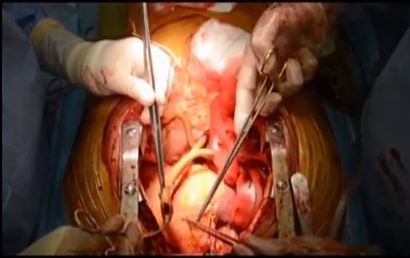ALERT!
This site is not optimized for Internet Explorer 8 (or older).
Please upgrade to a newer version of Internet Explorer or use an alternate browser such as Chrome or Firefox.
Hybrid Thoracoabdominal Aneurysm Repair with Abdominal Debranching

The treatment of thoracoabdominal aortic aneurysms continues to be a challenge in cardiovascular surgery. Recently, hybrid debranching and endovascular repair of extensive thoracoabdominal aneurysms became a suitable approach in those considered to be a high risk for open surgical repair. The procedure involves extra-anatomic bypasses to the celiac, renal, and superior mesenteric arteries based off the ascending aorta or iliac arteries. The endovascular portion of the repair can be performed concomitantly or in a second stage. The procedure does not require cardiopulmonary bypass.
This video shows a 53-year-old male patient with severe COPD. His computed angiography showed a Crawford Type I thoracoabdominal aneurysm. His right kidney was atrophic, and the aneurysm was extending just proximal to the left renal artery.
A median sternotomy combined with a upper midline laparotomy was performed to the level of the umbilicus. Exposure of the celiac artery was obtained through the lesser sac. The superior mesenteric artery was exposed through the mobilization of treitz ligament. A heparinization side biting clamp was then positioned and 14 x 7 mm aortobifemoral graft anastomosed to the ascending aorta. Distal anastomoses to the celiac and superior mesenteric arteries were performed in an end to side fashion. The origins of the native vessels were ligated.
The operating surgeons thought that it would be easier to insert the graft in an antegrade fashion for precise deployment just proximal to the renal arteries. After the visceral debranching procedure, a 7 mm sheath was introduced into the ascending aorta via prosthetic graft. A selective angiography was performed to demonstrate the patency of the visceral arteries. After this, stent graft deployment was achieved of ascending aorta with standard endovascular techniques. Postoperative imaging showed no endoleak, and complete exclusion of the aneurysm and patent visceral arteries. The patient was extubated in the OR.
In conclusion, hybrid debranching procedures may reduce early morbidity and mortality, and results are encouraging in a selected group of high-risk patients.




